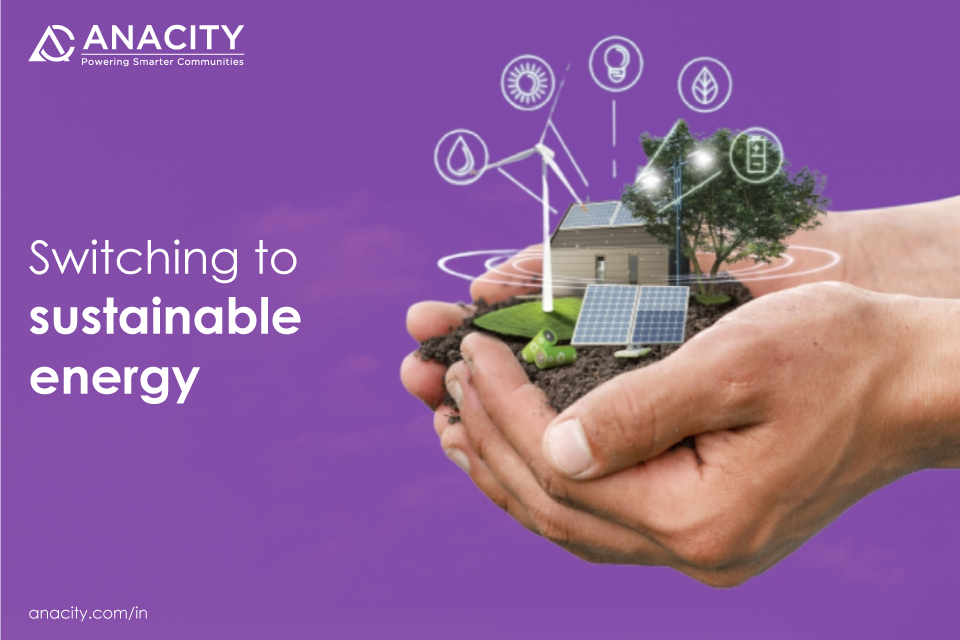How gated communities can transition to sustainable energy systems
Product NewsEnergy consumption in the residential sector accounts for very high usage, second only to the industrial sector. Consequently, bringing down this high energy consumption is often one of the biggest priorities for gated communities. However, short of switching off the power supply, bringing down usage can be nearly impossible. The solution, therefore, lies in switching to sustainable energy solutions.
What is sustainable energy?
Sustainable energy refers to those power sources that can be replenished within a human lifetime and cause no carbon emissions. Thus, it does not harm the atmosphere or contribute to global warming. The four main types of sustainable energy sources are solar power, wind power, bioenergy, and hydroelectric power.
For gated communities, solar panels have emerged as one of the most effective sustainable energy solutions. You can read more about its benefits in our article Solar Energy: A Sustainable Solution for Housing Societies.
How to transition to sustainable energy system
Switching to sustainable energy systems can require modifications in both infrastructure and resident consumption habits. This can cause disruptions and resistance from residents affected by the change. Hence, it is critical to follow a phased and planned transition to sustainable energy systems:
Conduct an energy audit
Start by understanding the current energy consumption patterns within the community. Identify which areas consume the most energy, such as lighting, heating, cooling, and common facilities. ApnaComplex Metered Utility Billing helps keep track of all metered utilities including electricity.
Set clear sustainability goals
Setting goals is important to check progress. It sets the purpose and forms a driving factor for all sustainability initiatives. Achieving these targets can also be a powerful motivator in continuing with sustainability initiatives. Establish clear goals and objectives for transitioning to sustainable energy. Define targets for reducing carbon emissions, energy consumption, and cost savings.
Community Engagement
Gathering member consensus is critical since transitioning to sustainable solutions can involve sizeable investments. Everyone must be on the same page when it comes to adopting sustainable consumption habits and investment in infrastructure modifications.
Conduct meetings or surveys to educate them about the benefits of sustainable energy and gather their input and support. You can also invite sustainability experts for workshops and help answer resident questions. Sustainability goals should be seen as a common community objective rather than an arbitrary decision by Management Communities or Resident Welfare Associations.
Assess renewable energy sources
Evaluate the renewable energy resources available in the community’s vicinity. This could include solar, wind, geothermal, or even micro-hydro power, depending on the location and resources. Small-scale wind turbines may work if the community is in a windy area. In most cases, rooftop solar panels are the most applicable solution.
Invest in smart energy-efficient appliances
Sustainable technology is our biggest friend when it comes to retrofitting buildings.
- Upgrade common area lighting and appliances to energy-efficient LED lights and energy star-rated appliances.
- Implement motion sensors and timers to reduce unnecessary energy consumption.
- Invest in energy storage systems like lithium-ion batteries to store excess energy generated by renewable sources for use during non-peak hours or emergencies.
- Implement a smart grid system to optimize energy distribution, monitor usage, and reduce wastage.
Energy-efficient landscaping
Use landscaping techniques to provide shade, reduce heat absorption, and improve insulation around buildings, reducing the need for air conditioning.
Installing EV charging stations
Install EV (electric vehicle) charging stations within the community to encourage residents to switch to electric vehicles. If your community is yet to make the switch, read our article Gated Communities Must Move Towards eMobility. Here’s How.
Financial incentives
Look for subsidies, tax breaks, incentives and rebates at the state, or central level to offset the initial costs of renewable energy installations. For instance, housing societies can apply for a 30% subsidy from the Ministry of New and Renewable Energy for rooftop solar panel installation.
Maintenance and monitoring
Establish a routine maintenance schedule to ensure all equipment continues to operate effectively. Implement monitoring systems to detect and address issues promptly. This can include additional training for the maintenance staff.
Educate and encourage residents
Conduct workshops and educational programs to teach residents about energy conservation and how to use the new sustainable energy systems effectively. Repeated messaging is important to ensure that residents stay aware.
Long-term planning
Develop a long-term sustainability plan that includes periodic evaluations and updates to incorporate new technologies and practices as they become available.
Partnerships and community resources
Collaborate with local energy providers, environmental organisations, and sustainability experts to gain knowledge, resources, and support for the transition.
Transitioning to sustainable energy solutions in gated communities requires careful planning, investment, and collaboration. It can lead to reduced energy costs, lower carbon emissions, and a more environmentally responsible and resilient community. Learn about more such initiatives in our article 5 Sustainable Living Practices Every Gated Community should Adopt.
